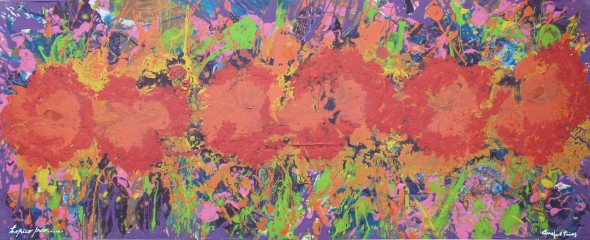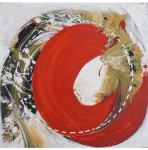Tropico Puro
Onofre Frias02/0Categoria: Pintura
T├®cnica: Acr├Łlica
Soporte: Tela
60 x 150 x 4
Material: MADERA
Estilo: Abstracto
Figurativo
 En exposici├│n
En exposici├│nPrecio Ōé¼ /
Usuario: OnofreFrias
Pa├Łs: Venezuela
Miembro desde:
2011-10-09
Web personal

Cultural and biological diversity of the Caribbean tropics provides a rich range of elements to be reinterpreted by the arts in all its expressions. It is a space full of encounters throughout history that has left us as a result a chromatic and rhythmic richness. Hence the study that has been done by the Venezuelan artist Onofre Frias in the last 20 years is derived. It is interpreting the relationship between popular culture + wildlife + Caribbean music, and then translate it into a visual language that dialogue with contemporary art. This creative process led by multistage where forms and rhythms are the thread up to this exhibition proposal called ONOSONORO. In the course of these lines we will review his aesthetic ideas and artistic production, we will see how the artistic approach Onofre is transformed without losing its essence.
Etnopl├Īstica ONOSONORO is a proposal where colors, sounds and celebratory expressions that are present in Latin America and particularly in the Caribbean, the product of our cultural hybridization merge. Simultaneously, the works harmonize these ideas with multiple trend inside and outside the arts. Here the artist refuses to take refuge in a traditional past as the only means for artistic creation. Therefore, the works in this exhibition synthesize a long process of aesthetic research is not limited to the development of a personal painting technique, but exploring both traditional and contemporary rhythms whose origins or components have strong ethnic character.
Thus, Onofre Frias creates a visual polyrhythmic that seeks to integrate the beauty of the tropical flora, the sound of Afro-Caribbean rhythms; the colors of the tropics and the strength of pictorial gesture, down to what the artist has called Pure Tropics. His works are a floral explosion that moves the senses and connects us with our feelings and identity. This is not to describe the nature, but to recreate the complexity of a territory. To Onofre, in these works it comes a new plant species, from the nature of art. A species of flora that synthesizes the splendor of Caribbean culture and environment; which could have a taxonomy.
Awareness of the polyrhythmic
In the late twentieth century Onofre Frias was exploring spirituality enclosing some of our beliefs and traditions. Inquired about the colors, sounds and popular celebrations that involve bodily expressiveness and magical-religious (cross Wakes, drums, offerings, etc.) rituals; and musical rhythms like jazz or soul. Many of these components have been present at various stages, building a proposed merger increasingly consolidated. Thus, in the late 90s it arises where Alma Flowers explores the spiritual and magical behind an offering. A state of tranquility that lies in the act of offering reinterpreted. It is shaping the boundless capacity for love of man, in its broadest sense, through a bouquet of flowers. Every bouquet is a sign of the sacred and religious, is the merger between the earthly and the divine, the visible and the invisible, the profane and the sacred. Moreover, this stage was characterized by the development of his painting technique where fabric with broad strokes that suggest ways to intervene flowers like: Roses, Cayenas, Capachos, Dating, Bromeliads, lilacs, petunias, orchids, all she employed in the offerings. Then covered with silk painting lets achieve transparency and unusual white. On this double surface images works from the inside out, driving the splendor of color.
Then he inquired into the magical world of beliefs and acts of "flirting" (Venezuelan popular term that indicates ritual to achieve a wish or good omens, such as prayer to a deity, offerings, body language, etc.), this step Grafts of Alma was called. In which he worked elements of the ritual, music and superstitions, characteristic of our cultural diversity. In these works Onofre Frias experimented with the crossing of languages, between reality and representation thereof; for that use flowers and symbolic forms. It was to merge aspects of popular culture with contemporary symbols and give a sensory reading these expressions, without describing or narrate.
This merger of culture, geography and tropical music events led him to analyze the perception of the senses and how they intersect, then hear and savor the view before the others; This idea is the basis of what the artist has called Visual Music. This step, called Full Color Caribbean, is a proposal that seeks to express the rhythms, flavors and scents of our Caribbean culture, which is ultimately define our essence and our way of seeing life. Here the flowers remain a major player and as such the artist's models, the recomposed, denies. Its flowers is part of the ritual, they represent deities, saints, affection; but sound score will also return. Flowers Onofre Frias allow you to "address the stereotype of the tropics, our colorful house". Full Color Caribbean seeks to raise our contemporary cultural approach based on a process of research that has been working etnopl├Īstica different cultural aspects that define us as Latin American and Caribbean values.
Finally, Onofre Frias has successfully synthesized the creative process in its current stage, called Pure Tropics. In which the visual pleasure is sought through the light intensity of color and playful organic shapes, as a visual sound that seduces the eye. Where the three main elements of his work are combined: flora, music and color; to present a proposal polyrhythmic. This plant employs around him, such as heliconia, bromeliads, hibiscus and family platanillos (Birds of Paradise); the rhythms of the Caribbean (lambada, calypso, samba or salsa) and the use of pure and strongly contrasting colors. These elements are the basis for the free establishment of new plant species Floris Karibius starring the series. Thus ONOSONORO emerges as a curatorial proposal where notes and chords visual explode in a concert of sensations, a tasting of colors that seduce the senses.
Zaida Garcia Valecillo. 2015
www.onofrefrias.com
- 3 obras del artista
Copyright: Onofre Frias ┬®
Atenci├│n: Esta totalmante prohibida la reproducci├│n de las obras en otros medios electronicos o impresos sin la autorizaci├│n del autor. Si te interesa la obra contacta con el autor.
Atenci├│n: Esta totalmante prohibida la reproducci├│n de las obras en otros medios electronicos o impresos sin la autorizaci├│n del autor. Si te interesa la obra contacta con el autor.
La perfecci├│n no es cosa peque├▒a, pero est├Ī hecha de peque├▒as cosas. Miguel ├üngel Buonarroti
© Artistas y arte. Artistas de la tierra 2006-2007
Las mejores obras del Mundo - Promociona gratis tus obras de arte
Artistas y arte. Artistas de la tierra ha sido creado para ser una herramienta al servicio de los artistas de la Tierra
Condiciones de uso - Pol├Łtica de protecci├│n de datos
Artistas y arte. Artistas de la tierra





